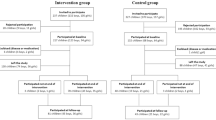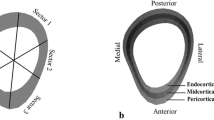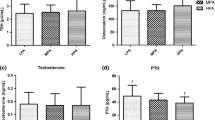Abstract
The aim of this study was to evaluate the effect of increasing the amount of time spent in physical education classes on bone mineral accrual and gain in bone size in prepubertal Danish children. A total of 135 boys and 108 girls, aged 6–8 years, were included in a school-based curriculum intervention program where the usual time spent in physical education classes was doubled to four classes (180 min) per week. The control group comprised age-matched children (62 boys and 76 girls) recruited from a separate community who completed the usual Danish school curriculum of physical activity (90 min/week). Dual-energy X-ray absorptiometry was used to evaluate bone mineral content (BMC; g), bone mineral density (g/cm2), and bone width at the calcaneus and distal forearm before and after 3 years of intervention. Anthropometrics and Tanner stages were evaluated on the same occasions. General physical activity was measured with an accelerometer worn for 4 days. In girls, the intervention group had a 12.5% increase (P = 0.04) in distal forearm BMC and a 13.2% increase (P = 0.005) in distal forearm scanned area compared with girls in the control group. No differences were found between the intervention and control groups in boys. Increasing the frequency of physical education classes for prepubertal children is associated with a higher accrual of bone mineral and higher gain in bone size after 3 years in girls but not in boys.

Similar content being viewed by others
References
Davies JH, Evans BAJ, Gregory JW (2005) Bone mass acquisition in healthy children. Arch Dis Child 90:373–378
Cummings SR, Black DM, Nevitt MC, Browner W, Cauley J, Ensrud K, Genant HK, Palermo L, Scott J, Vogt TM (1993) Bone density at various sites for prediction of hip fractures. The Study of Osteoporotic Fractures Research Group. Lancet 341:72–75
Rubin CT, Lanyon LE (1984) Regulation of bone formation by applied dynamic loads. J Bone Joint Surg Am 66:397–402
Kannus P, Haapasalo H, Sankelo M, Sievanen H, Pasanen M, Heinonen A, Oja P, Vuori I (1995) Effect of starting age of physical activity on bone mass in the dominant arm of tennis and squash players. Ann Intern Med 123:27–31
Lanyon LE, Rubin CT (1984) Static vs. dynamic loads as an influence on bone remodelling. J Biomech 17:897–905
Khan K, McKay HA, Kannus P, Bailey DA, Wark JD, Bennell KL (2001) Physical activity and bone health. Human Kinetics, Champaign, IL
Sundberg M, Gardsell P, Johnell O, Karlsson MK, Ornstein E, Sandstedt B, Sernbo I (2002) Physical activity increases bone size in prepubertal boys and bone mass in prepubertal girls: a combined cross-sectional and 3-year longitudinal study. Calcif Tissue Int 71:406–415
Gutin B, Kasper MJ (1992) Can vigorous exercise play a role in osteoporosis prevention? A review. Osteopor Int 2:55–69
Forwood MR, Burr DB (1993) Physical activity and bone mass: exercise infutility? Bone Mineral 21:89–112
Nordström P, Pettersson U, Lorentzon R (1998) Type of physical activity, muscle strength, and pubertal stage as determinants of bone mineral density and bone area in adolescent boys. J Bone Miner Res 13:1141–1148
Morris FL, Naughton GA, Gibbs JL, Carlson JS, Wark JD (1997) Prospective 10-month exercise intervention in premenarcheal girls: positive effects on bone and lean mass. J Bone Miner Res 12:1453–1462
Bradney M, Pearce G, Naughton G, Sullivan C, Bass S, Beck T, Carlson J, Seeman E (1998) Moderate exercise during growth in prepubertal boys: changes in bone mass, size, volumetric density, and bone strength: a controlled prospective study. J Bone Miner Res 13:1814–1821
MacKelvie KJ, McKay HA, Petit MA, Moran O, Khan KM (2002) Bone mineral response to a 7-month randomized controlled, school-based jumping intervention in 121 prepubertal boys: associations with ethnicity and body mass index. J Bone Miner Res 17:834–844
McKay HA, Petit MA, Schultz RW, Prior JC, Barr SI, Khan KM (2000) Augmented trochanteric bone mineral density after modified physical education classes: a randomized school-based exercise intervention study in prepubescent and early pubescent children. J Pediatr 136:156–162
MacKelvie KJ, Khan KM, Petit MA, Janssen PA, McKay HA (2003) A school-based exercise intervention elicits substantial bone health benefits: a 2-year randomized controlled trial in girls. Pediatrics 112:e447–e452
MacKelvie KJ, Petit MA, Khan KM, Beck TJ, McKay HA (2004) Bone mass and structure are enhanced following a 2-year randomized controlled trial of exercise in prepubertal boys. Bone 34:755–764
MacKelvie KJ, McKay HA, Khan KM, Crocker PR (2001) A school-based exercise intervention augments bone mineral accrual in early pubertal girls. J Pediatr 139:501–508
Valdimarsson O, Linden C, Johnell O, Gardsell P, Karlsson MK (2006) Daily physical education in the school curriculum in prepubertal girls during 1 year is followed by an increase in bone mineral accrual and bone width—data from the prospective controlled Malmo Pediatric Osteoporosis Prevention Study. Calcif Tissue Int 78:65–71
Linden C, Alwis G, Ahlborg H, Gardsell P, Valdimarsson O, Stenevi-Lundgren S, Besjakov J, Karlsson MK (2007) Exercise, bone mass and bone size in prepubertal boys: one-year data from the Pediatric Osteoporosis Prevention Study. Scand J Med Sci Sports 17:340–347
Linden C, Ahlborg HG, Besjakov J, Gardsell P, Karlsson MK (2006) A school curriculum–based exercise program increases bone mineral accrual and bone size in prepubertal girls: two-year data from the Pediatric Osteoporosis Prevention (POP) study. J Bone Miner Res 21:829–835
Bailey RC, Olson J, Pepper SL, Porzasz J, Barstow TJ, Cooper DM (1995) The level and tempo of children’s physical activities: an observational study. Med Sci Sports Exerc 27:1033–1041
De Lorenzo A, Bertini I, Candeloro N, Iacopino L, Andreoli A, Van Loan MD (1998) Comparison of different techniques to measure body composition in moderately active adolescents. Br J Sports Med 32:215–219
Altmann DG (1991) Practical Statistics for Medical Research. Chapman & Hall, London
Janz KF, Burns TL, Levy SM, Torner JC, Willing MC, Beck TJ, Gilmore JM, Marshall TA (2004) Everyday activity predicts bone geometry in children: the Iowa Bone Development Study. Med Sci Sports Exerc 36:1124–1131
Janz KF, Burns TL, Torner JC, Levy SM, Paulos R, Willing MC, Warren JJ (2001) Physical activity and bone measures in young children: the Iowa Bone Development Study. Pediatrics 107:1387–1393
Ridgers ND, Stratton G, Fairclough SJ (2005) Assessing physical activity during recess using accelerometry. Prev Med 41:102–107
Riddoch CJ, Bo AL, Wedderkopp N, Harro M, Klasson-Heggebo L, Sardinha LB, Cooper AR, Ekelund U (2004) Physical activity levels and patterns of 9- and 15-yr-old European children. Med Sci Sports Exerc 36:86–92
Trost SG, Pate RR, Sallis JF, Freedson PS, Taylor WC, Dowda M, Sirard J (2002) Age and gender differences in objectively measured physical activity in youth. Med Sci Sports Exerc 34:350–355
Hasselstrom H, Karlsson KM, Hansen SE, Gronfeldt V, Froberg K, Andersen LB (2006) Sex differences in bone size and bone mineral density exist before puberty. The Copenhagen School Child Intervention Study (CoSCIS). Calcif Tissue Int 79:7–14
Bailey DA, McKay HA, Mirwald RL, Crocker PR, Faulkner RA (1999) A six-year longitudinal study of the relationship of physical activity to bone mineral accrual in growing children: the University of Saskatchewan Bone Mineral Accrual Study. J Bone Miner Res 14:1672–1679
Bass S, Pearce G, Bradney M, Hendrich E, Delmas PD, Harding A, Seeman E (1998) Exercise before puberty may confer residual benefits in bone density in adulthood: studies in active prepubertal and retired female gymnasts. J Bone Miner Res 13:500–507
Fuchs RK, Bauer JJ, Snow CM (2001) Jumping improves hip and lumbar spine bone mass in prepubescent children: a randomized controlled trial. J Bone Miner Res 16:148–156
McKay HA, Petit MA, Bailey DA, Wallace WM, Schutz RW, Khan KM (2000) Analysis of proximal femur DXA scans in growing children: comparisons of different protocols for cross-sectional 8-month and 7-year longitudinal data. J Bone Miner Res 15:1181–1188
Cussler EC, Going SB, Houtkooper LB, Stanford VA, Blew RM, Flint-Wagner HG, Metcalfe LL, Choi JE, Lohman TG (2005) Exercise frequency and calcium intake predict 4-year bone changes in postmenopausal women. Osteoporos Int 16:2129–2141
Robling AG, Hinant FM, Burr DB, Turner CH (2002) Improved bone structure and strength after long-term mechanical loading is greatest if loading is separated into short bouts. J Bone Miner Res 17:1545–1554
Bass SL, Saxon L, Daly RM, Turner CH, Robling AG, Seeman E, Stuckey S (2002) The effect of mechanical loading on the size and shape of bone in pre-, peri-, and postpubertal girls: a study in tennis players. J Bone Miner Res 17:2274–2280
Janz K (2002) Physical activity and bone development during childhood and adolescence. Implications for the prevention of osteoporosis. Minerva Pediatr 54:93–104
Branca F, Valtuena S, Vatuena S (2001) Calcium, physical activity and bone health–building bones for a stronger future. Public Health Nutr 4:117–123
Haapasalo H, Kontulainen S, Sievanen H, Kannus P, Jarvinen M, Vuori I (2000) Exercise-induced bone gain is due to enlargement in bone size without a change in volumetric bone density: a peripheral quantitative computed tomography study of the upper arms of male tennis players. Bone 27:351–357
Kontulainen S, Sievanen H, Kannus P, Pasanen M, Vuori I (2003) Effect of long-term impact-loading on mass, size, and estimated strength of humerus and radius of female racquet-sports players: a peripheral quantitative computed tomography study between young and old starters and controls. J Bone Miner Res 18:352–359
Duan Y, Seeman E, Turner CH (2001) The biomechanical basis of vertebral body fragility in men and women. J Bone Miner Res 16:2276–2283
Seeman E, Duan Y, Fong C, Edmonds J (2001) Fracture site–specific deficits in bone size and volumetric density in men with spine or hip fractures. J Bone Miner Res 16:120–127
Ahlborg HG, Johnell O, Turner CH, Rannevik G, Karlsson MK (2003) Bone loss and bone size after menopause. N Engl J Med 349:327–334
Duan Y, Parfitt A, Seeman E (1999) Vertebral bone mass, size, and volumetric density in women with spinal fractures. J Bone Miner Res 14:1796–1802
Acknowledgments
Supported by funding from the Danish Heart Foundation, the National Board of Health, the Danish Ministry of Health, the Danish Ministry of Culture, and the Danish Sport Association.
Author information
Authors and Affiliations
Corresponding author
Rights and permissions
About this article
Cite this article
Hasselstrøm, H.A., Karlsson, M.K., Hansen, S.E. et al. A 3-Year Physical Activity Intervention Program Increases the Gain in Bone Mineral and Bone Width in Prepubertal Girls but not Boys: The Prospective Copenhagen School Child Interventions Study (CoSCIS). Calcif Tissue Int 83, 243–250 (2008). https://doi.org/10.1007/s00223-008-9166-x
Received:
Accepted:
Published:
Issue Date:
DOI: https://doi.org/10.1007/s00223-008-9166-x




